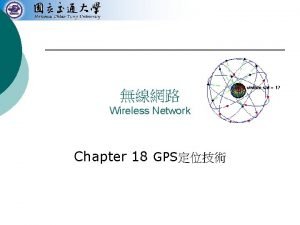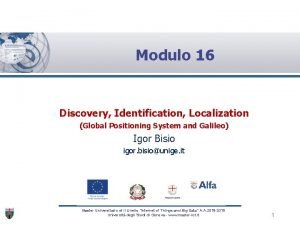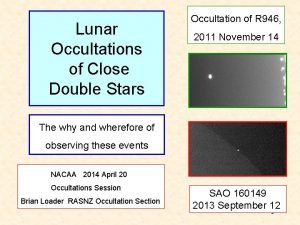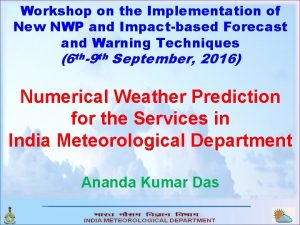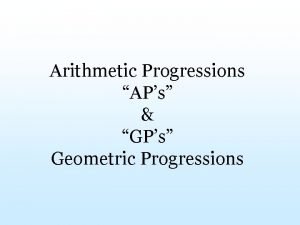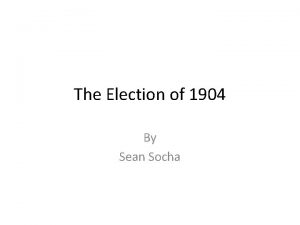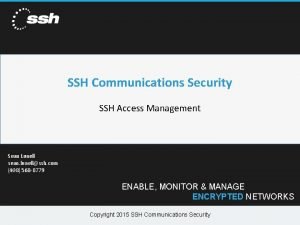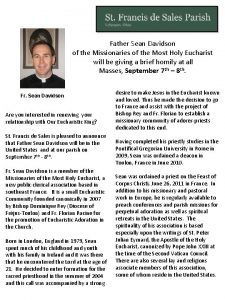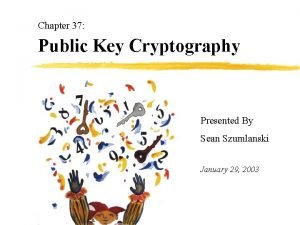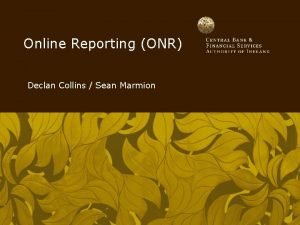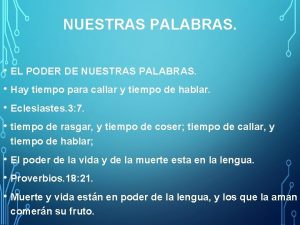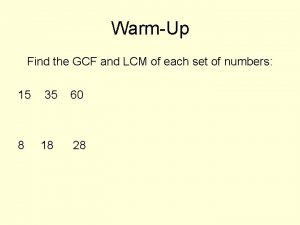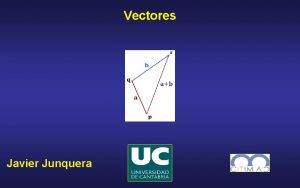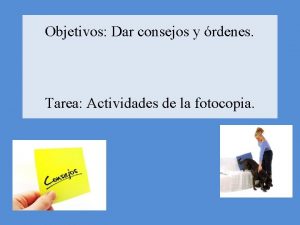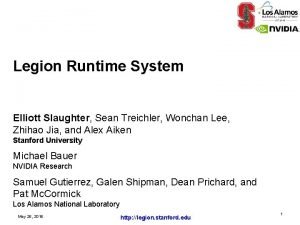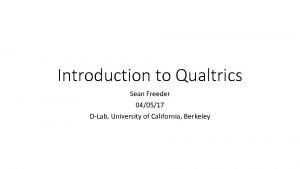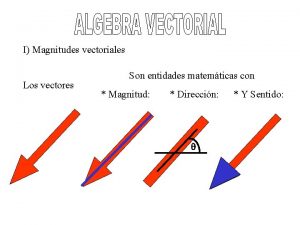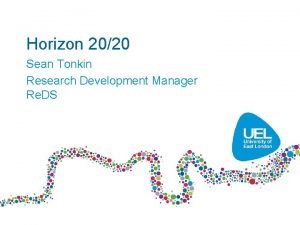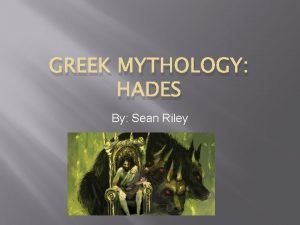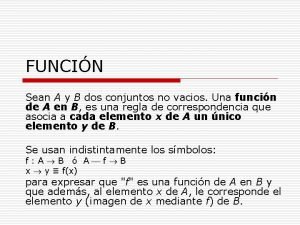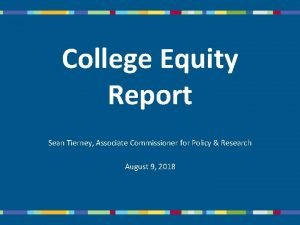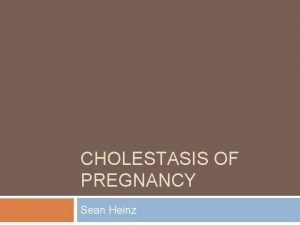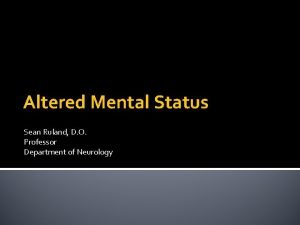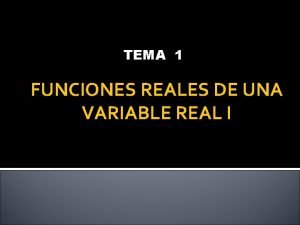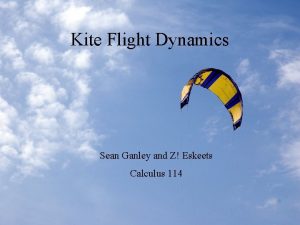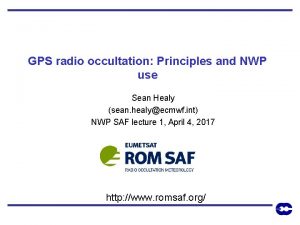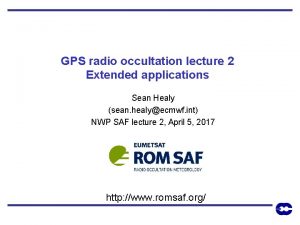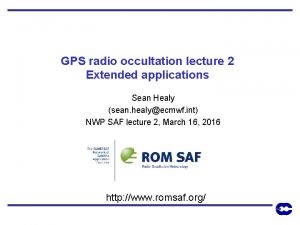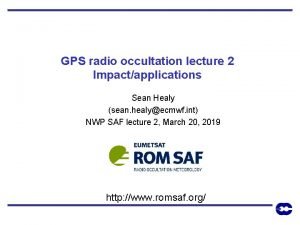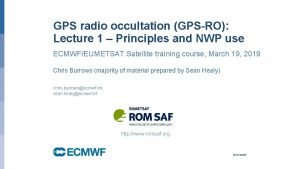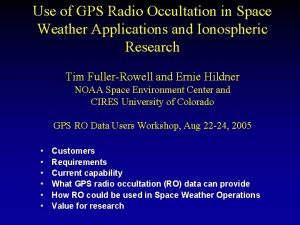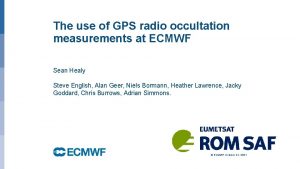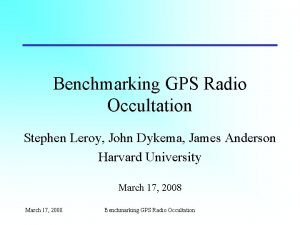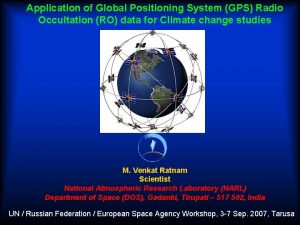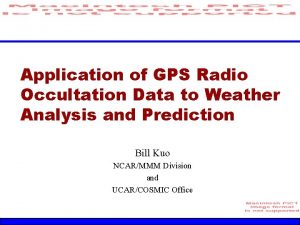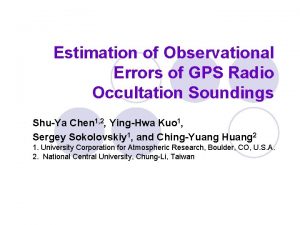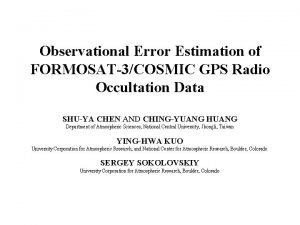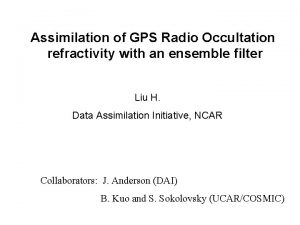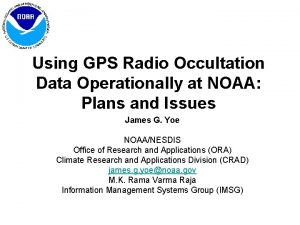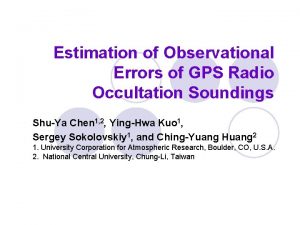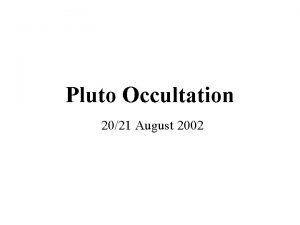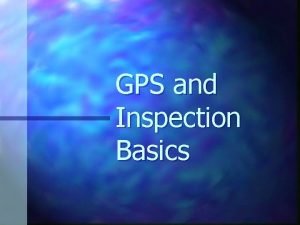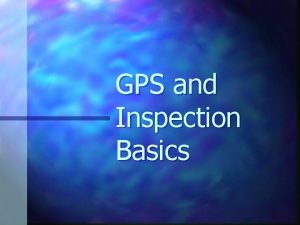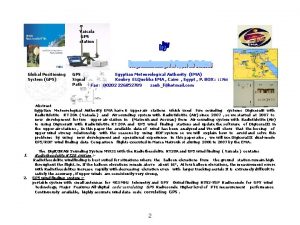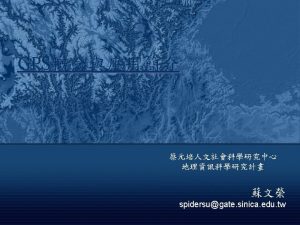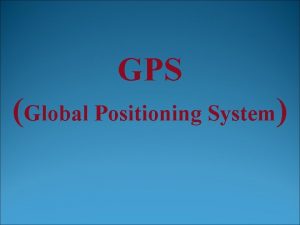GPS radio occultation Principles and NWP use Sean






























































- Slides: 62

GPS radio occultation: Principles and NWP use Sean Healy (sean. healy@ecmwf. int) NWP SAF lecture 1, March 15, 2016 http: //www. romsaf. org/

Outline • GPS (should really be “GNSS”) measurement geometry. • Basic physics, some history … • GPS radio occultation and “Classical” GPS RO retrieval. • Some limitations. • Information content and resolution estimates from 1 D-Var. • 4 D-Var assimilation of GPS RO measurements (GPS RO null space). • Move to more complicated 2 D operators. • Summary and conclusions.

Measurements made using GPS signals GPS Radio Occultation (Profile information) LEO GPS Ground-based GPS (Column integrated water vapour) GPS receiver on the ground GPS Receiver placed on satellite Wind speed information from scattered signal

The basic GPS-RO physics – Snel’s Law (Not “Snell”, Peter Janssen) • Refractive index: Speed of an electromagnetic wave in a vacuum divided by the speed through a medium. • Snel’s Law of refraction

Radio Occultation: Some Background • Radio occultation (RO) measurements have been used by to study planetary atmospheres (Mars, Venus) since the 1960’s. Its an active technique. How the paths of radio signals are bent by refractive index gradients in the atmosphere. • The use of RO measurements in the Earth’s atmosphere was originally proposed in 1965, but required the advent of the GPS constellation of satellites to provide a suitable source of radio signals. • Use of GPS signals discussed at the Jet Propulsion Laboratory (JPL) in late 1980’s. In 1996 the proof of concept “GPS/MET” experiment demonstrated useful temperature information could be derived from the GPS RO measurements.

GPS-RO: Basic idea The GPS satellites are primarily a tool for positioning and navigation These satellites emit radio signals at L 1= 1. 57542 GHz and L 2=1. 2276 GHz (~20 cm wavelength). The GPS signal velocity is modified in the ionosphere and neutral atmosphere because the refractive index is not unity, and the path is bent because of gradients in the refractive index. GPS-RO is based on analysing the bending caused by the neutral atmosphere along ray paths between a GPS satellite and a receiver placed on a low-earth-orbiting (LEO) satellite.

GPS RO geometry (Classical mechanics: Compare this picture with the deflection of a charged particle by a spherical potential!) Tangent point 20, 200 km αa 800 km Setting occultation: as the LEO moves behind the earth we obtain a profile of bending angles, a, as a function of impact parameter, . The impact parameter is the distance of closest approach for the straight line path. It is directly analogous to angular momentum of a particle.

GPS RO characteristics §Good vertical resolution. Around 70% of the bending occurs over a ~450 km section of ray-path, centred on the tangent point (point closest to surface) – it has a broad horizontal weighting function, with a ~Gaussian shape to first order! §All weather capability: not affected by cloud or rain. §The bending is ~1 -2 degree at the surface, falling exponentially with height. The scale-height of the decay is approximately the density scale-height. §A profile of bending angles from ~60 km tangent height to the surface takes about 2 minutes. Tangent point drifts in the horizontal by ~200 km during the measurement.

Ray Optics Processing of the GPS RO Observations GPS receivers do not measure temperatures/ray bending directly! The GPS receiver on the LEO satellite measures a time series of phase-delays f(i-1), f(i+1), … at the two GPS frequencies: L 1 = 1. 57542 GHz L 2 = 1. 22760 GHz The phase delays are “calibrated” to remove special and general relativistic effects and to remove the GPS and LEO clock errors (“Differencing”, see Hajj et al. (2002), JASTP, 64, 451 – 469). Calculate Excess phase delays: remove straight line path delay, Df(i). A time series of Doppler shifts at L 1 and L 2 are calculated by differentiating the excess phase delays with respect to time.

Processing of the GPS-RO observations (2) The ray bending caused by gradients in the atmosphere and ionosphere modify the L 1 and L 2 Doppler values, but deriving the bending angles, a, from the Doppler values is an ill-posed problem (an infinite set of bending angles could produce the Doppler ). The problem made well posed by assuming the impact parameter, given by y r has the same value at both the satellites. Given accurate position and velocity estimates for the satellites, and making the impact parameter assumption, the bending angle, a, and impact parameter value can be derived simultaneously from the Doppler shift. LEO

The ionospheric correction We have to isolate the atmospheric component of the bending angle. The ionosphere is dispersive and so we can take a linear combination of the L 1 and L 2 bending angles to obtain the “corrected” bending angle. See Vorob’ev + Krasil’nikov, (1994), Phys. Atmos. Ocean, 29, 602 -609. “Corrected” bending angles Constant given in terms of the L 1 and L 2 frequencies. How good is the correction? Does it introduce time varying biases that with solar cycle? YES, the retrieved temperatures will be sensitive to this!

The ionospheric correction: A simulated example L 1 L 2 Assumed error above ~30 km Log scale The “correction” is very big!

Deriving the refractive index profiles Assuming spherical symmetry the ionospheric corrected bending angle can be written as: Corrected Bending angle as a function of impact parameter Convenient variable (x=nr) (refractive index * radius) We can use an Abel transform to derive a refractive index profile Note the upper-limit of the integral! A priori information needed to extrapolate to infinity.


Refractivity and Pressure/temperature profiles: “Classical retrieval” The refractive index (or refractivity) is related to the pressure, temperature and vapour pressure using two experimentally determined constants (from the 1950’s and 1960’s!) refractivity This two term expression is probably the simplest formulation for refractivity, but it is widely used in GPSRO. We now use an alternative three term formulation, including non-ideal gas effects If the water vapour is negligible, the 2 nd term = 0, and the refractivity is proportional to the density So we have retrieved a vertical profile of density!

“Classical” retrieval We can derive the pressure by integrating the hydrostatic equation a priori The temperature profile can then be derived with the ideal gas law: GPSMET experiment (1996): Groups from JPL and UCAR demonstrated that the retrievals agreed with co-located analyses and radiosondes to within 1 K between ~5 -25 km. EG, See Rocken et al, 1997, JGR, 102, D 25, 29849 -29866.

GPS/MET Temperature Sounding (Kursinski et al, 1996, Science, 271, 1107 -1110, Fig 2 a) GPS/MET - thick solid. Radiosonde – thin solid. Dotted - ECMWF anal. Results like this by JPL and UCAR in mid 1990’s got the subject moving. (Location 69 N, 83 W. 01. 33 UT, 5 th May, 1995)

Some subtleties, limitations, complications … GPS-RO is useful data, BUT if you want to assimilate any new data, you have to think about the limitations of the technique in order to: • choose a reasonable assimilation strategy (e. g. , noting again that GPS-RO does not measure temperature directly). • obtain a realistic error covariance matrix estimate, R. Limitations: In GPS-RO we often talk about the core region - a vertical interval between ~8 -35 km - where the GPS-RO information content is highest. The GPSRO signal-to-noise falls outside this interval.

GPS-RO limitations – upper stratosphere In order to derive refractivity the noisy, corrected bending angle profiles must be extrapolated to infinity – i. e. , we have to introduce a-priori simulated bending angles. This blending of the observed and simulated bending angles is called “statistical optimisation”. Consider the (matrix) equation: We use this “blended” Model (e. g. MSIS) profile in the Abel transform to get refractivity! “Corrected” BA It’s a linear combination of simulated bending angles from a climatology model (e. g. , MSIS) The gain matrix, K, determines the relative contribution of the model. By ~60 km the merged profile is dominated by the model contribution.

Upper stratosphere (2) The refractivity profile is retrieved from the statistically optimised bending angles. But we also need to estimate the temperature on a pressure level to integrate the hydrostatic equation Overall, I would be sceptical about GPS-RO temperature retrievals above ~5 h. Pa. Be aware that the temperature will be very sensitive to the a priori.

Outside the core-region Troposphere: we can’t neglect water vapour Difference between the lines show the impact of water vapour. Simulated ignoring water vapour.

Physical limitations in lower troposphere Atmospheric defocusing: If the bending angle changes rapidly with height, the signal reaching the receiver has less power A tube of rays is spread out by the ray bending and the signal to noise falls. Atmospheric ducting: if the refractive index gradient exceeds a critical value the signal is lost Not affected by clouds? But we often get ducting conditions near the top of stratocumulus clouds

Maximum bending angle value (related to defocusing) Seems obvious but the receiver has to be measuring a long time to see the large bending angle values. We rarely see an observed bending above ~0. 05 rads.

Limitations – lower troposphere • Atmospheric Multipath processing – more than one ray is measured by the receiver at a given time: Single ray region – geometric ray optics approach ok! Multipath: More than one ray arrives at the receiver. They interfere. • The amplitude of the signal can fluctuate rapidly. • Wave optics retrievals – these are elegant co-ordinate transforms (assuming spherical symmetry): e. g, Full Spectral Inversion. Jensen et al 2003, Rad. Sci. , 38, 10. 1029/2002 RS 002763. Canonical transforms, Gorbunov and Lauritsen, 2004, Rad. Sci. , 39, RS 4010, doi: 10. 1029/2003 RS 002971 • Improved GPS receiver software: Open-loop processing.

Example of amplitude at the receiver. Standard atmospheric defocusing Basically ~time

Horizontal gradient errors • The impact parameter – that we assume is constant – actually varies along the ray-path. We can assign the wrong height to the “measurement!

Data availability • The “proof of concept” GPS/MET mission in 1996 was a major success. This led to a number of missions of opportunity, proposals for a constellation of LEO satellites and first dedicated operational instruments. • Current status: – Missions of opportunity: GRACE-A/B, Terra. SAR-X and Tandem-X. – The COSMIC constellation of (originally) 6 LEO satellites was launched 2006. Now providing ~800 - 900 occultations per day (~2200 at peak). – The GRAS instruments on Metop-A and Metop-B provides ~1300 measurements. GRAS is the only fully operational instrument. GRAS on METOP-B has been assimilated since May 21, 2013.


Why are GPS RO useful for NWP given that we already have millions of radiance measurements? GPS-RO complements the radiances! Observations are useful if they provide new information. 1) RO can be assimilated without bias correction. They are good for highlighting model errors/biases. Most other satellite observations require bias correction to the model. GPS-RO measurements anchor the bias correction of radiance measurements. Importance of anchor measurements in weak constraint 4 D-Var. (Climate/reanalysis applications). 2) GPS RO (limb sounders in general) have sharper weighting functions in the vertical and therefore have good vertical resolution properties. The GPSRO measurements can “see” vertical structures that are in the “null space” of the satellite radiances.

Use of GPS RO in NWP • NWP centres assimilate either bending angle (most now) or refractivity. • The classical retrieval is very useful for understanding the basic physics of the measurement, but not recommended for use in NWP. – The pre-processing steps and a-priori information required to retrieve temperature complicate the errors. • We can test 1 D bending angle and refractivity observation operators in 1 D-Var retrievals to estimate the information content and vertical resolution of the measurements.

1 D-Var retrieval The 1 D-Var retrieval minimises the cost function: The observation operator simulating bending angles or refractivity from the forecast state. The 1 D-Var approach provides a framework for testing observation operators that we might use in 3 D/4 D-Var assimilation. We can also investigate various information content measures.

1 D bending angle weighting function (Normalised with the peak value) Weighting function peaks at the pressure levels above and below the ray tangent point. Bending related to vertical gradient of refractivity: Sharp structure near the tangent point hydrostatic tail (See also Eyre, ECMWF Tech Memo. 199. ) Increase the T on the lower level – reduce the N gradient – less bending! Increase the T on the upper level – increase N gradient more bending! Very sharp weighting function in the vertical – we can resolve structures that nadir sounders cannot!

Useful 1 D-Var diagnostics • 1 D-Var provides an estimate of the solution error covariance matrix. • Information content: related to the uncertainty before and after the measurement is made. • It also gives vertical resolution diagnostics – the averaging kernel. Linearised forward model Solution error cov. matrix Assumed background error cov. Matrix. Assumed observation error cov. matrix

GPS-RO and IASI: 1 DVAR simulations Healy and Collard 2003, QJRMS: Power to resolve a peak-shaped error in background: Averaging Kernel. IASI Expected retrieval error: RO+IASI RO RO Background IASI

1 D bending angle assimilation at Met Office, NCEP, MF, ECMWF (until 2014) • Most centres assimilate bending angles with a 1 D operator: ignore the 2 D nature of the measurement and integrate • Convenient variable (x=nr) The forward model is quite simple: (refractive index * radius) – evaluate geopotential heights of model levels – convert geopotential height to geometric height and radius values – evaluate the refractivity, N, on model levels from P, T and Q. – Integrate, assuming refractivity varies ~(exponentially*quadratic) between model levels. (Solution in terms of the Gaussian error function). – Include tangent point drift (May 2011). – 2 D operator operational at ECMWF since 2014 (later in talk).

1 D bending angle assimilation at Met Office, NCEP, MF, ECMWF (until 2014) • Most centres assimilate bending angles with a 1 D operator: ignore the 2 D nature of the measurement and integrate Note the dependence on geopotential height and Q in the forward model! • Convenient variable (x=nr) The forward model is quite simple: In principle, GPS-RO provides surface (refractive index * radius) – evaluate geopotential heights of model levels pressure and tropospheric humidity – convert geopotential height to geometric height and radius values information. – evaluate the refractivity, N, on model levels from P, T and Q. – Integrate, assuming refractivity varies ~(exponentially*quadratic) between model levels. (Solution in terms of the Gaussian error function). – Include tangent point drift (May 2011). – 2 D operator operational at ECMWF since 2014 (later in talk).

Assumed (global) observation errors and actual (o-b) departure statistics Consistent with o-b stats. See http: //www. grassaf. org/monitoring/

Impact of GPS-RO on ECMWF operational biases against radiosonde measurements Operational implementation

Stratospheric ringing problem over Antarctica solved by assimilating GPS-RO

GPS RO also has a “null space” • The measurement is related to density (~P/T) on height levels and this ambiguity means that the effect of some temperature perturbations can’t be measured. Assume two levels separated by z, with temperature variation T(z) between them. Now add positive perturbation ΔT(z)~exp(z/H), where H is the density scale height P and T have increased at z, but the P/T is the same. Pu, Tu, (P/T)u T(z)+ΔT(z) z, T(z) z 2=z+Δz z P, T, P/T • The density as a function of height is almost unchanged. A priori information required to distinguish between these temperature profiles. This is the GPS-RO null space.

Null space – how does a temperature perturbation propagate through the bending angle observation operator 1 K at ~25 km Assumed ob errors The null space arises because the measurements are sensitive to density as function of height (~P(z)/T(z)). A priori information is required to split this into T(z) and P(z). We can define a temperature perturbation ΔT(z)~exp(z/H) which is in the GPSRO null space. Therefore, if the model background contains a bias of this form, the measurement can’t see or correct it.

Compare with Steiner et al (Ann. Geophs. , 1999, 17, 122 -138) Temperature retrieval error caused by a 5 % bias in the background bending angle used in the statistical optimization

Recent observing system experiments (OSEs) at ECMWF to put GPS-RO impact in context See Mc. Nally (2014): http: //www. ecmwf. int/sites/default/files/elibrary/2014/14686 -impact-satellite-data-global-nwp. pdf

Observations Considered All conventional (in situ) data CONV TEMP/AIRCRAFT/SYN OP/SHIP All Satellite Data SAT Microwave sounding radiances MWS 7 x AMSUA, 1 x ATMS, 4 x MHS Infrared sounding radiances IRS 2 x IASI, 1 x AIRS, 1 x HIRS All GEO data (AMVs and radiances) GEO 2 x GOES, 2 x METEOSAT, 1 x MTSAT, polar AMVs GPS-RO bending angle data GPS COSMIC, 2 x METOPGRAS, GRACE-A Microwave imager radiances MWI 1 x TMI, 1 x SSM/IS Scatterometer surface wind data SCAT 2 x ASCAT

Observations Considered All conventional (in situ) data CONV TEMP/AIRCRAFT/SYN OP/SHIP All Satellite Data SAT Microwave sounding radiances MWS All GEO data (AMVs and radiances) GEO 2 x GOES, 2 x METEOSAT, 1 x MTSAT, polar AMVs GPS-RO bending angle data GPS COSMIC, 2 x METOPGRAS, GRACE-A Microwave imager radiances MWI 1 x TMI, 1 x SSM/IS Scatterometer surface wind data SCAT 7 x AMSUA, 1 x ATMS, 4 x MHS GPS-RO only represents of order 3% of the data Infrared sounding IRS 2 x IASI, 1 x AIRS, 1 x assimilated! radiances HIRS 2 x ASCAT

Day-3 Forecasts of 500 h. Pa Z over NH To see changes clearly we need to difference with the errors of the CONTROL and normalise with the errors of the CONTROL . . . Series 1 . . Forecast error (m) 0 0. 05 0. 15 Fractional change (wrt CONTROL)

OSE 500 z (NH-24 h)

OSE 500 z (SH-24 h)

OSE 500 z (NH-Day 6) N. . . NO. . . Series 1 N. . . -0. 01 0. 02 0. 03 0. 04 0. 05 0. 06 0. 07 0. 08

OSE 500 z (SH-Day 6)

24 hr 850 RH in the Tropics

72 hr 850 RH in the Tropics

Upper level temperatures

GPS-RO impact on temperature NO GPS

GPS-RO impact on temperature

Factors limiting GPS-RO impact • It has been suggested that the use of 1 D operators is limiting the GPS-RO impact in the troposphere. • ECMWF now assimilated GPS-RO with a 2 D operator. • This complicates the forward model.

Move towards 2 D GPS-RO operators • The 2 D operators take account of the real limb nature of the measurement, and this should reduce the forward model errors defined as Forward model error Noise free observation Discrete representation of true state from model • Reducing the forward model errors should improve our ability to retrieve information from the observation, but this must be balanced: Extra Information versus Additional Computing Costs. • We are less likely to misinterpret information with a 2 D operator.

2 D operator assimilation Rodgers Page 149 The 2 D operator requires NWP information interpolated to a plane. 1 D

~80 km 1 D/2 D hybrid approach ray path Interpolate 2 D information to the ray path 2 d computation for ray path below ~80 km surface Computational cost Occultation plane described by 31 profiles with 40 km separation.

Improvement in GPS-RO (o-b) departure statistics with 2 D approach Impact height (km) NH, COSMIC-1 (Full observing system)

Summary • GPS RO is a satellite-to-satellite limb measurement. • Outlined the basic physics of the GPS RO technique and the “classical” retrieval. • Measurements do not require bias correction. The 1 D observation operators are quite simple. Very good vertical resolution, but poor horizontal resolution (~450 km average). Also, be wary of classical temperature retrievals above 35 -40 km. They mainly contain a-priori information. • Information content studies suggest GPS RO should provide good temperature information in the upper troposphere and lower/mid stratosphere. Operational assimilation and recent OSEs supports this. • Some impact in troposphere but other observing systems have bigger impact. • 2 D operator implemented at ECMWF. Improves modelling of observations.

Useful GPSRO web-sites • International Radio Occultation Working Group (IROWG) www. irowg. org. • The COSMIC homepage www. cosmic. ucar. edu. This contains latest information on the status of COSMIC and an extensive list of papers www. cosmic. ucar. edu/references. html, with some links to. pdfs of the papers, workshops. • The Radio Occultation Meteorology (ROM) SAF homepage www. grassaf. org. – You can find lists of ROM SAF publications www. grassaf. org/publications. – Links to GPS RO monitoring pages (Data quality, data flow of GRAS, COSMIC, GRACE-A, …). – In addition, you can register and download for the ROM SAF’s Radio Occultation Processing Package (ROPP). This F 90 software package containing preprocessing software modules, 1 D-Var minimization code, bending angle and refractivity observation operators and their tangent-linears and adjoints. – 2015 and 2008 ECMWF/ROM SAF Workshops papers and presentations. www. ecmwf. int/newsevents/meetings/workshops/2008/GPS_radio_occultation/ index. html. www. ecmwf. int/en/fifth-eumetsat-rom-saf-user-workshop-applications-gps-radiooccultation-measurements
 Gps gps gps
Gps gps gps Modulo positioning
Modulo positioning Double occultation
Double occultation Nwp imd
Nwp imd Trunking vs conventional radio system
Trunking vs conventional radio system Aps and gps
Aps and gps How you use ict today and how you will use it tomorrow
How you use ict today and how you will use it tomorrow Sean furman
Sean furman Fur coat short story questions and answers
Fur coat short story questions and answers Socha svobody
Socha svobody Courage zone 7 habits
Courage zone 7 habits Nistir 7966
Nistir 7966 Sean marsee
Sean marsee Dr fernandez psychiatrist
Dr fernandez psychiatrist Cambia las oraciones para que sean negativas
Cambia las oraciones para que sean negativas Fr sean davidson
Fr sean davidson Sean strout rit
Sean strout rit Sean szumlanski
Sean szumlanski Bowdoin computer science
Bowdoin computer science Algun dia cuando mis hijos sean lo suficientemente grandes
Algun dia cuando mis hijos sean lo suficientemente grandes Sean imitadores mios como yo lo soy de cristo
Sean imitadores mios como yo lo soy de cristo Sean tabor
Sean tabor Spacemen's autographs answers
Spacemen's autographs answers Dr sean keyes orlando
Dr sean keyes orlando Dr sean dingle
Dr sean dingle Sean marmion
Sean marmion El poder de nuestras palabras
El poder de nuestras palabras Oooo
Oooo Dr sean kraekel
Dr sean kraekel Sean perich net worth
Sean perich net worth Flannery mullins
Flannery mullins Sean kelly pwc
Sean kelly pwc Keywords for lcm and hcf
Keywords for lcm and hcf Producto escalar de dos vectores
Producto escalar de dos vectores Maddie burke
Maddie burke Sean ren
Sean ren No ser oidores sino hacedores de la palabra
No ser oidores sino hacedores de la palabra John lennon and salvador dali
John lennon and salvador dali Dar mandato afirmativo
Dar mandato afirmativo Sean treichler
Sean treichler Qualtrics randomize answer choices
Qualtrics randomize answer choices Sean los vectores
Sean los vectores Sean tonkin
Sean tonkin Hades flaws
Hades flaws Gcf and lcm word problems key words
Gcf and lcm word problems key words 6 paso aa
6 paso aa Fisica vectores
Fisica vectores Dr sean maika
Dr sean maika Sean tierney indiana
Sean tierney indiana Sean heinz
Sean heinz Dr sean ruland
Dr sean ruland Que los mejores momentos sean los que están por llegar
Que los mejores momentos sean los que están por llegar Vayan pues y hagan que todos los pueblos
Vayan pues y hagan que todos los pueblos Sean f y g funciones de variable real tales que
Sean f y g funciones de variable real tales que Sean lichtfuss
Sean lichtfuss Sean layne
Sean layne Taylor bartel
Taylor bartel My perspective
My perspective Benditas sean todas las familias de la tierra
Benditas sean todas las familias de la tierra Sean stotyn
Sean stotyn Sean ganley
Sean ganley Pressors icu
Pressors icu Convertro
Convertro
